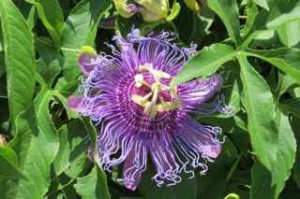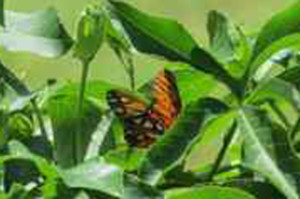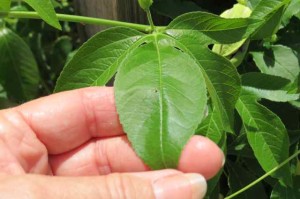by Sheryl Kleinschmidt, Somervell County Master Gardener
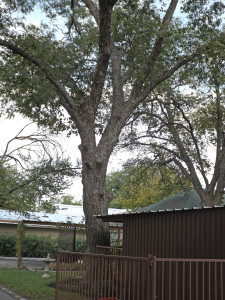 One deciding factor in choosing my house in Glen Rose was the fact that “the tree” was on the property. Being a tree-hugger/appreciator, it was love at first sight when I saw the old native pecan hugging the carport behind the house. This sturdy tree has stood guard near the Paluxy River for well over a century—his girth will attest to that fact alone.
One deciding factor in choosing my house in Glen Rose was the fact that “the tree” was on the property. Being a tree-hugger/appreciator, it was love at first sight when I saw the old native pecan hugging the carport behind the house. This sturdy tree has stood guard near the Paluxy River for well over a century—his girth will attest to that fact alone.
Old Man isn’t the only native pecan in my yard, but he is the biggest and has thrown his weight around (literally) more than once. He has been known to shed some rather large limbs, seemingly at will, in some rather inconvenient places such as my neighbor’s driveway!
But, even with the surliness that comes with age, Old Man has his finer points. For starters, he gives me much-needed shade from the Texas heat, puts off a lot of fresh oxygen, and looks good in the landscape. The squirrels are especially fond of him and lie on his knotty (arthritis?) ledges for naps. He also is a quiet companion when family or friends come over to sit around the fire pit beneath his branches—or maybe he’s just napping.
After living with Old Man for seven years now, I’ve gotten to know his habits fairly well. For instance, he has only been generous with his pecan crop once in all this time—the year when even the acorns were abundant (2012). Given we’ve been in a drought for several years, I can’t fault him too much, but I would appreciate a little more effort on his part! Native pecans generally produce every other year, but they will adapt to survive. I guess Old Man must be thinking of self-preservation.
Now I must tell you of the trick Old Man played the year of the big harvest (2012). Between him and the other pecan trees, I had more nuts than the grandchildren and I felt like harvesting. There were pecan pies, cookies, roasted pecans, and nuts in the freezer! I’d give anything to have another year like that one.
One morning as I was kicking around the grass in search of yet more pecans, my eye zeroed in on a huge, round pecan—no not just one, there were two, three……then more. Where did these come from? Old Man’s tasty pecans were small, round natives. I picked up the strange fruit and put them in my sack, the whole time looking over my shoulder for the trickster who tossed them out. I even considered that a squirrel had carried them in from across the street and dropped them. 
Continuing my harvesting routine, I took a few more steps only to find oval-shaped pecans in the mix. Okay, now I knew someone was messing with me. This continued on/off for a couple of weeks until I consulted an expert who explained what was going on.
Apparently, an early settler grafted some other pecan wood onto Old Man when he was but a youngster. Since these branches are on top of Old Man’s head, they are not easily seen from the ground (he’s very tall). For some reason, the grafted branches had not produced fruit for me up until the big harvest year.
Yes, Old Man stymied and stumped (pun intended) me alright, but now I’m onto his tricks. So far, I have found 2 of the large, round pecans that fell during the thunderstorm last week. I expect he’ll toss me another one or two just to keep me interested, but it doesn’t look like we’ll have much pecan pie this year!
But, given his history and stamina, I must give Old Man his due respect. After all, my relationship with him will be found in but a few tree rings that record his life here on earth. He was here long before I was born and will likely surpass me by decades—I hope that is the case. To your health, Old Man!
 American beautyberry is a fast growing native perennial shrub; growing five to eight feet tall and almost as wide. It has long, arching branches and yellow-green fall foliage, but its most striking feature is the clusters of glossy, iridescent – purple fruit (sometimes white) which hug the branches in clusters along the branches in the fall and winter.
American beautyberry is a fast growing native perennial shrub; growing five to eight feet tall and almost as wide. It has long, arching branches and yellow-green fall foliage, but its most striking feature is the clusters of glossy, iridescent – purple fruit (sometimes white) which hug the branches in clusters along the branches in the fall and winter.
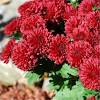
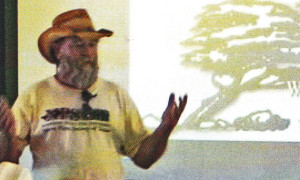
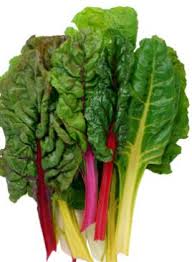
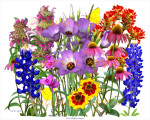 This is your last chance to get wildflower seeds out as well but get to it quick. Make sure there is good seed to soil contact for best germination. Fall rains and Mother Nature should take care of the rest.
This is your last chance to get wildflower seeds out as well but get to it quick. Make sure there is good seed to soil contact for best germination. Fall rains and Mother Nature should take care of the rest.

